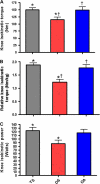Effects of age and sedentary lifestyle on skeletal muscle NF-kappaB signaling in men
- PMID: 20045871
- PMCID: PMC2904591
- DOI: 10.1093/gerona/glp196
Effects of age and sedentary lifestyle on skeletal muscle NF-kappaB signaling in men
Abstract
Background: Nuclear factor kappa B (NF-kappaB) is a critical signaling molecule of disuse-induced skeletal muscle atrophy. However, few studies have carefully investigated whether similar pathways are modulated with physical activity and age.
Methods: The present study examined lean mass, maximal force production, and skeletal muscle NF-kappaB signaling in 41 men categorized as sedentary (OS, N = 13, 63.85 +/- 6.59 year), physically active (OA, N = 14, 60.71 +/- 5.54 year), or young and sedentary (YS, N = 14, 21.35 +/- 3.84 year). Muscle tissue from the vastus lateralis was assayed for messenger RNA (mRNA) expression of the beta subunit of IkB kinase (IKKbeta), cytosolic protein content of phosphorylated inhibitor of kappa B alpha (pIKBalpha), and nuclear content of NF-kappaB subunits p50 and p65.
Results: When compared with YS, OS demonstrated age-related muscle atrophy and reduced isokinetic knee extension torque. Physical activity in older individuals preserved maximal isokinetic knee extension torque. OS muscle contained 50% more pIKBalpha than OA and 61% more pIKBalpha than YS. Furthermore, nuclear p65 was significantly elevated in OS compared with YS. OS muscle did not differ from either of the other two groups for nuclear p50 or for mRNA expression of IKKbeta.
Conclusions: These results indicate that skeletal muscle content of nuclear-bound p65 is elevated by age in humans. The elevation in nuclear-bound p65 appears to be at least partially due to significant increases in pIKBalpha. A sedentary lifestyle appears to play some role in increased IKBalpha; however, further research is needed to identify downstream effects of this increase.
Figures



Similar articles
-
Activation of an alternative NF-kappaB pathway in skeletal muscle during disuse atrophy.FASEB J. 2002 Apr;16(6):529-38. doi: 10.1096/fj.01-0866com. FASEB J. 2002. PMID: 11919155
-
[Xinfeng capsule improves hypercoagulative state by inhibiting miR-155/NF-κB signaling pathway in patients with active ankylosing spondylitis].Xi Bao Yu Fen Zi Mian Yi Xue Za Zhi. 2016 Aug;32(8):1094-8. Xi Bao Yu Fen Zi Mian Yi Xue Za Zhi. 2016. PMID: 27412942 Clinical Trial. Chinese.
-
A contralateral repeated bout effect attenuates induction of NF-κB DNA binding following eccentric exercise.J Appl Physiol (1985). 2014 Jun 1;116(11):1473-80. doi: 10.1152/japplphysiol.00133.2013. Epub 2013 Aug 15. J Appl Physiol (1985). 2014. PMID: 23950163
-
Nuclear factor-κB signalling and transcriptional regulation in skeletal muscle atrophy.Exp Physiol. 2013 Jan;98(1):19-24. doi: 10.1113/expphysiol.2011.063321. Epub 2012 Jul 30. Exp Physiol. 2013. PMID: 22848079 Free PMC article. Review.
-
Nuclear factor κB signaling revisited: Its role in skeletal muscle and exercise.Free Radic Biol Med. 2025 May;232:158-170. doi: 10.1016/j.freeradbiomed.2025.02.013. Epub 2025 Feb 24. Free Radic Biol Med. 2025. PMID: 40010515 Review.
Cited by
-
Difference in sarcopenia characteristics associated with physical activity and disability incidences in older adults.J Cachexia Sarcopenia Muscle. 2021 Dec;12(6):1983-1994. doi: 10.1002/jcsm.12801. Epub 2021 Oct 5. J Cachexia Sarcopenia Muscle. 2021. PMID: 34612020 Free PMC article.
-
Emerging roles for histone deacetylases in age-related muscle atrophy.Nutr Healthy Aging. 2016 Oct 27;4(1):17-30. doi: 10.3233/NHA-160005. Nutr Healthy Aging. 2016. PMID: 28035339 Free PMC article. Review.
-
Study on relationship between elderly sarcopenia and inflammatory cytokine IL-6, anti-inflammatory cytokine IL-10.BMC Geriatr. 2018 Dec 12;18(1):308. doi: 10.1186/s12877-018-1007-9. BMC Geriatr. 2018. PMID: 30541467 Free PMC article.
-
Models of accelerated sarcopenia: critical pieces for solving the puzzle of age-related muscle atrophy.Ageing Res Rev. 2010 Oct;9(4):369-83. doi: 10.1016/j.arr.2010.04.004. Epub 2010 May 14. Ageing Res Rev. 2010. PMID: 20438881 Free PMC article. Review.
-
(-)-Epicatechin induces mitochondrial biogenesis and markers of muscle regeneration in adults with Becker muscular dystrophy.Muscle Nerve. 2021 Feb;63(2):239-249. doi: 10.1002/mus.27108. Epub 2020 Dec 16. Muscle Nerve. 2021. PMID: 33125736 Free PMC article.
References
-
- Berg HE, Dudley GA, Haggmark T, Ohlsen H, Tesch PA. Effects of lower limb unloading on skeletal muscle mass and function in humans. J Appl Physiol. 1991;70:1882–1885. - PubMed
-
- Lexell J, Taylor CC, Sjostrom M. What is the cause of the ageing atrophy? Total number, size and proportion of different fiber types studied in whole vastus lateralis muscle from 15- to 83-year-old men. J Neurol Sci. 1988;84:275–294. - PubMed
-
- Tisdale MJ. Cancer cachexia. Langenbecks Arch Surg. 2004;389:299–305. - PubMed
-
- Cai D, Frantz JD, Tawa NE, Jr,, et al. IKKbeta/NF-kappaB activation causes severe muscle wasting in mice. Cell. 2004;119:285–298. - PubMed
Publication types
MeSH terms
Substances
Grants and funding
LinkOut - more resources
Full Text Sources
Medical
Research Materials

